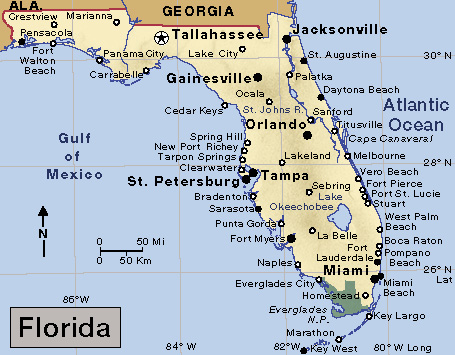Fort Lauderdale, << LAW duhr `dayl` >> (pop. 182,760), is a major resort city in Florida. It lies on the Atlantic Ocean in the southeastern part of the state, approximately 25 miles (40 kilometers) north of Miami. Fort Lauderdale’s location and warm climate have made it a leading vacation and retirement center.

During the 1800’s, Seminole Indians lived in what is now Fort Lauderdale. White settlers, most of whom farmed and fished for a living, first arrived in the area in the 1890’s. They named their settlement after a fort that Major William Lauderdale had built there in 1838, during the Second Seminole War.
Description.
Fort Lauderdale, the county seat of Broward County, covers about 36 square miles (94 square kilometers). This area includes 2 square miles (5 square kilometers) of inland water. Fort Lauderdale has about 165 miles (265 kilometers) of navigable canals and waterways. The city also has about 7 miles (11 kilometers) of ocean beaches, where people can go boating, fishing, and swimming.
Fort Lauderdale is part of the Miami-Fort Lauderdale-West Palm Beach metropolitan area. This area has a population of 6,138,333 and consists of Broward, Miami-Dade, and Palm Beach counties. Fort Lauderdale is also part of the Fort Lauderdale-Pompano Beach-Sunrise metropolitan division, which covers Broward County and has 1,944,375 people.
Nova Southeastern University (NSU) and a few campuses of Florida Atlantic University are in or near the city. Cultural attractions in the city include the Broward Center for the Performing Arts, the NSU Art Museum, and the Parker Playhouse. Fort Lauderdale has a ballet company.
Marine commerce and tourism are important industries in the city. Port Everglades, at the south end of Fort Lauderdale, serves as a major port for cargo ships and passenger cruisers. Major airlines use Fort Lauderdale-Hollywood International Airport.
Government and history.
Fort Lauderdale has a commission-manager form of government. The voters in the city elect a mayor and four commissioners to a four-year term. The commissioners hire a city manager to serve as the chief administrator of Fort Lauderdale’s local government.
The city had a population of only about 150 when it was incorporated in 1911. After World War II ended in 1945, a tourist boom resulted in a rapid population growth. Fort Lauderdale received national attention during the 1960’s, when thousands of college students began to spend their spring vacation there.
During the last half of the 1900’s, Fort Lauderdale’s continued population growth made it one of the fastest growing cities in the United States. The city’s population rose from about 18,000 in 1940 to about 150,000 in 1990.
Fort Lauderdale’s population growth slowed during the 1990’s and the first two decades of the 2000’s. However, the population of the metropolitan area increased greatly. Much of the growth and economic development in the metropolitan area has occurred in the western part of Broward County. That area has a number of campuslike facilities that house offices and light manufacturing firms.
In 1990, a gigantic outlet shopping mall called Sawgrass Mills opened in Sunrise, west of Fort Lauderdale. The mall attracts millions of visitors every year. In 2001, Sawgrass Mills completed the addition of a large entertainment complex.
